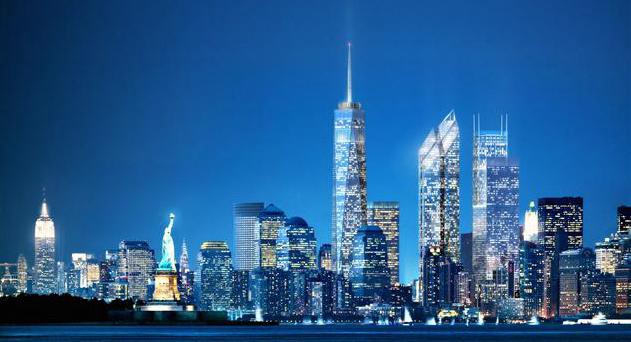Spaceport New York

When One World Trade Center formally opens next week, it will not have a fancy restaurant at the very top of the building, like Windows on the World in the North Tower of the World Trade Center before it, even though the building’s owner, the Port Authority, originally planned for one. Instead, the Port Authority realized, its top three floors would be more valuable as functionally empty space — it will be an observation area for an expected three-and-a-half million people a year.
According to the Wall Street Journal, The revenue produced by this massive observation space — which the Port Authority hopes will approach some fifty-three million dollars annually by 2019, or around one quarter of the building’s revenues — will help it fill in the gap caused by site’s nearly four-billion-dollar construction costs. (If, by 2019, the building pulls in the hundred and forty-four million dollars a year it is expecting, it will only be generating the kind of income that a three-billion-dollar building is currently expected to make.)
Further uptown, at the luxury condo building One57, a thirteen-and-a-half-thousand-square-foot penthouse known as the Winter Garden, which was purchased for ninety million dollars, making it the most most expensive single apartment in Manhattan’s history, sits empty. It will continue to do so, but “for the occasional party,” because its owner, William Ackman, the activist investor and founder of Pershing Square Capital Management, has no plans whatsoever to relocate his family from their current Upper West Side residence. Rather, “myself and a couple of very good friends bought into this idea that someday, someone will really want it and they’ll let me know.”
This is not so uncommon in Mr. Ackman’s new not-neighborhood, the Times notes:
In a three-block stretch of Midtown, from East 56th Street to East 59th Street, between Fifth Avenue and Park Avenue, 57 percent, or 285 of 496 apartments, including co-ops and condos, are vacant at least 10 months a year. From East 59th Street to East 63rd Street, 628 of 1,261 homes, or almost 50 percent, are vacant the majority of the time, according to data from the Census Bureau’s 2012 American Community Survey.
Further:
Take the Trump Tower at 721 Fifth Avenue, between East 56th Street and East 57th Street. The building has 237 units, with some priced at more than $25 million. As of last year, 211 apartments claimed the tax abatement, but this year, as a result of the rule change, the city decided that only 108 apartments were eligible, according to figures from the Independent Budget Office, a nonpartisan city agency. That is a drop of nearly 50 percent and means that fewer than half of the apartments in the building are primary residences. At the Plaza, of 163 condominiums, only 58, or about one-third of them, now receive the abatement for full-time residents.
So many apartments, so few people. The bizarre proportions of residences to residents will only contort further as the rest of the new Midtown erupts, skinny, shiny spikes sticking into the sky, barely occupied by the billionaires and less-fortunate multi-millionaires who’ve purchased their own distinctive piece of the new New York City skyline so few have asked for.
The people who pass through the observation decks as tourists at One World Trade Center will pay a little more than thirty dollars to spend twenty minutes or so staring out over New York City. The people who pass through some of these condos as transient owners have spent twenty or thirty million, or maybe a little more, to spend twenty or thirty hours or so, staring out over New York City. There’s probably something practical to be said about the structure of real estate taxes and the absurd way they allow properties to be valued, for tax purposes, at a fraction of their worth, or how they allow largely out-of-town buyers to use ultra-lux condos as “stash pads” with minimal tax burdens. But, really, this is just the triumph of possibility over utility, of space over people.
